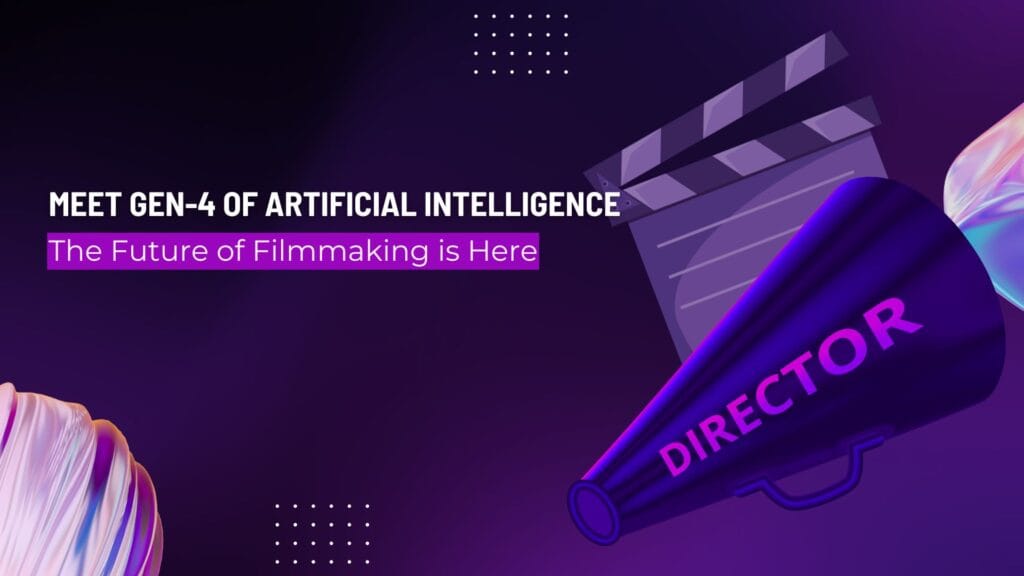With time, filmmaking has turned to be an art of creativity, technology, and most importantly, a story. Such is the dynamic of training that always throws up new challenges at intervals, but every so often, a block is set, marking a new frontier. Well, flicker on to Gen-4-,4 which is taking a revolutionary approach to artificial intelligence in rewriting the script of making movies. Starting with the scriptwriting and ending with the post-production, Gen-4 is not only a tool, but rather a revolution that inherits mountains of work, setting generations of filmmakers an entirely new set of standards. That is why now, when entering the new generation, we can confidently state that Gen-4 is not the future due to the fact that.

What is Gen-4?
The Gen-4 is the fourth generation of Artificial Intelligence technology applied in filmmaking that includes a range of intelligent tools, applications, and robots used to help in, supplement, and even substitute several processes of filmmaking. The experience gained through many years of work, as well as through innovations and experiments, the fourth generation – Gen-4. Unlike the Gen-3 that was more inclined towards automation of editing or utilization of CGI to make movies, Gen-4 offers an encompassing system that covers brainstorming and pre-production, production and post-production all the way to post-production. Gen-4 can be seen as a continuation of the previous generations with differentiation lying in the anchor tools, which were tools for handling separate aspects of filmmaking, such as facial animation or green screen. But the transition from separated variants of a single function to an end-to-end process with AI is a transition to Gen-4. This generation is not an addition but is a brand-new level altogether.
Gen-4’s Impact on Editing and Post-Production
Post-production should remain one of the most widely recognized concerns of the film industry, mainly due to the fact that it is meant to be one of the most time-consuming steps in the entire process of filmmaking. Colour correction, sound mixing, editing, and integration of special effects may range from weeks to months to complete. Gen-4 changes that narrative entirely. Through the use of other situational and improved technologies of automation and Pattern recognition, Editing is no longer a fixed, centralized, static process.
Key features of Gen-4 in Editing
- Automated rough cuts: Gen-4 watches ALL raw footage and makes first assembly editing’s as per script reference, match action/smoothness of the scene.
- Eligible shots: Identifies duplicate shots and their quality criteria consist of light variation, sound quality, and actors’ energy levels.
- Auto colour grading: This feature enables the styled colour grading that comes with the conventional style or the director style.
- Dialogue isolation: It can amplify or exclude various dialogue lines without the need to perform ADR.
A quick comparison of traditional post-production vs. Gen-4-enhanced post:
| Feature | Traditional Workflow | Gen-4 Workflow |
| Rough Cut Creation | Manual, time-intensive | AI-generated in minutes |
| Colour Grading | Requires expert input | Automated, style-matching |
| Audio Sync and Clean-up | Manual syncing & editing | Real-time sync with enhancement |
| VFX Integration | Outsourced or late-stage | On-the-fly, real-time VFX |
| Editor Collaboration | Linear, layered editing | Cloud-based, parallel workflows |
Gen-4 in Animation and Virtual Production
Some of the film production methods use AI to a certain degree: animation and virtual production use AI at a higher level than traditional filmmaking, but Gen-4 raises this to a new level even further. It can be used in conjunction with intelligent rigging, motion capture for AI animation and a generative design to erase such obstacles.
Rather, the Gen-4 forms virtual production tools that deliver:
- Simulation of the physical environment in games and realistic light simulation.
- Appendage characters are based on rough silhouettes and sometimes even a simple line drawing/concept art.
- Natural motion capture through webcam-based body tracking or voice synthesis.
Just think about drawing each shot with simple story telling in a short film. Gen-4 achieves that through converting the voice statement into moving scene along with background action, camera and mouths’ moving in synchronization with the speaking.
Users of LED Volumes
For users of LED volumes or green screens, Gen-4 assists:
- Feasible to alter the lighting and specifically light the subjects according to the virtual environment.
- Imitate environmental factors such as wind, water, or fire during the shooting process.
- Be able to preview compositing scenes on the same model without the task requiring the final rendering process.
Use Cases in Animation/Virtual Production
- Indie creators producing animated shorts
- Filmmaking facilities that specialize in the preparation of screen visuals and movement for movies with many stunts
- YouTubers are building virtual sets for commentary
Democratizing Filmmaking: Accessibility and Affordability
The other potential of Gen-4 that has been talked about frequently is democratization. Filmmaking at large has always been an expensive affair, but now with the help of Artificial Intelligence, which takes over most of the tedious work, it has slowly become more diverse and diverse.
Regardless of whether you are an ordinary student, an up-and-coming indie director, or an amateur content maker who is yet to establish his channel on a limited budget, Gen-4 offers you:
- Affordable licenses and open-source tools
- Cloud-based rendering and storage
- Templates for cinematography, storyboarding, and filming techniques/templates for VFX
Key Benefits for Small Teams:
- It prevents the need to hire full VFX teams
- One way to provide various compliance necessary for the work, such as Copyright-safe audio/video, is through AI.
- Collaborative tools for remote teams
In other words, Gen-4 is a movie studio from a laptop perspective – this means that in this generation, talent and imagination outrank cash.
Ethical Considerations and Creative Control
Despite the technology’s efficacy, it garnered several issues. Where do the human artists stand when Gen-4 is capable of generating even scripts, performances, and visuals?
In moving pictures, the ethical dilemmas outlined as follows are feasible:
- Authorship: Who owns AI-generated content?
- Bias stemming from training data of AI: Is it possible for Gen-4 to reinstate discrimination?
- Explaining the concept of deep fake and how this technology can be potentially misused.
The creators and developers are putting efforts into creating the ethical codes and configuring the watermarking techniques, which will make it possible to ensure that all productions created with the help of Gen-4 technologies are as transparent and accountable as possible.
The Future Ahead: Where Gen-4 is going next
The Gen-4 system is evolving daily. It means that each production makes it possible to have continuous learning capabilities that help to make the subsequent one smarter. The roadmap ahead includes:
- Synthesizing the narrative where the prompt is in the form of voice and the output is a displayed movie.
- AI-generated actors with consistent voice, behaviour, and performance
- A global social platform where filmmakers can in real time on films.
It’s not a story of tool replacement but the complete reinvention of the nature of filmmaking in its principal. It will probably stun everyone if I said that the cinema family is now entering the generation IV. Of media tools and each director is to open the door to the new generation with the key in his hand.
Conclusion
The Gen-4 generation does not just redefine the process of filmmaking, but such important stages as scriptwriting, cinematography, editing and animation. Gen-4 is equipped with flexible creativity, ethical elements, as well as innovative cornerstone to tell the otherwise untold stories.
For filmmakers innocent and experienced, the embrace of Gen-4 is a move into the future where creativity is confronted by plenitude possibilities. And that future? It’s already here.
FAQs
Can Gen-4 create a full movie without human involvement?
The apparent ability of the algorithms to solve certain practical problems, they cannot yet implement creativity in terms of feeling, coherence or the artist’s vision.
How expensive is Gen-4 technology?
There are scalable solutions available, most of the tools are free or cost money only for very small creators, while there are solutions for studios.
Is Gen-4 only useful for sci-fi or VFX-heavy films?
Not at all. This means low-budget documentary films, dramas, animated movies, and even short films get increased efficiency in editing, scriptwriting, and much more.
4. Will Gen-4 replace traditional filmmakers?
No. It was created to complement the position of a filmmaker and not to take the place of the filmmaker.
5. How do I start using Gen-4 tools?
There are many Gen-4 solutions available online in terms of some free tutorials, forums, and assistance. This means you need to first start very small and try the first things, then gradually set up your strategy as you go along.



One Response
MIND BLOWING :-O